![]()
![]()
![]()
Use LEFT and RIGHT arrow keys to navigate between flashcards;
Use UP and DOWN arrow keys to flip the card;
H to show hint;
A reads text to speech;
143 Cards in this Set
- Front
- Back
- 3rd side (hint)
|
What are the postulates of cell theory? |
1. All organisms are composed of one of more cells. 2. Cells are the smallest unit of life. 3. All cells come from pre-existing cells. |
There are three and they have to do with what they do, what they are and where they come from. |
|
|
What are the functions of life? |
1. Metabolism 2. Growth 3. Reproduction 4. Irritability 5. Homeostasis 6. Nutrition |
My Great Relative Is Horribly Nosy. |
|
|
What does each function of life encompass? |
1. Chemical reactions within the body 2. Repair, replacement. 3. DNA passed on to offspring. 4. Response to stimuli. 5. Maintenance of constant internal conditions. 6. Ingestion, digestion, absorption and utilization of nutrients to maintain life. |
|
|
|
States the relative sizes to the cell. |
Subatomic particles < atoms < molecules < thickness of cell membrane < viruses < bacteria < eukaryotic organelles < cells < tissues < organs < organisms. |
Sing All Morning Time Voices Ballads Existing Or Calls Truly Owned Originally. |
|
|
In what forms do all organisms exist? |
All organisms exist in either unicellular or multicellular forms. |
|
|
|
What do all organisms do? |
All organisms carry out the functions of life. |
|
|
|
Why are there limits to the size that a cell can be? |
Size is limited to the surface area to volume ratio. Metabolic activities often depend on the volume of cytosol within the cells and the membrane surface area across which resources must pass. (If you really understand this, you should be able to explain this in your own words). |
Volume to surface area ratio. |
|
|
How and why might the relationship volume and surface area be modified? |
Depending on the function, cells may modify this relationship by increasing in length (nerve cells) or invaginating (microvilli). |
Changing their shape. |
|
|
Multicellular organisms begin life as... |
...A single cell (zygote) after sexual reproduction. |
|
|
|
Miotic division follows the creation of a zygote after reproduction creating... |
...A cluster of identical cells each having identical DNA. |
Identical. |
|
|
When does differentiation begin? |
Differentiation begins when certain genes (DNA segments) are expressed while others are suppressed. |
Expressed and suppressed.
|
|
|
What do some cells do once specialized? |
Some cells retain the ability to reproduce like cells while others are greatly limited. |
Reproduction.
|
|
|
What are stem cells? |
Stem cells are cells which retain the ability to reproduce and differentiate. |
Reproduce and differentiate.
|
|
|
Where are stem cells found in plants? |
Meristemation tissue in stem and root tips. |
|
|
|
Where are stem cells found in animals? |
Embryotic cells are called pluripotent. |
|
|
|
Human stem cells are the basis of... |
...therapeutic cloning techniques. |
Alzheimer's and Parkinson's |
|
|
How are Parkinson's and Alzheimer's caused and how can they be treated? |
They result from a loss of brain cells. Stem cells can be implanted to replace lost brain cells. |
Stem cells. |
|
|
What does Canadian law prohibit under the guidelines of the CIHR? |
The creation of embryos for research. This includes the somatic cell nuclear transfer on Human Therapeutic Cloning. |
Therapeutic cloning. |
|
|
How does Human Therapeutic Cloning Work? |
Licensed researchers substitute the DNA from an informed donor for the nucleus of an egg from another informed donor. |
Informed donor. |
|
|
Name two advantages of therapeutic cloning techniques. |
1. An embryo created would contain stem cells capable of turning into brain cells, liver cells, etc. 2. Because the donor's own DNA is in the cells, the risk that the body might reject the cells is reduced. |
|
|
|
Name a disadvantage of using stem cells obtained from adult humans. |
The cells are not as flexible as embroytic stem cells. |
|
|
|
Name a disadvantage of using stem cells obtained from tissue of aborted foetuses. |
The DNA is of the couple who created the foetuses or embryos. |
|
|
|
How are life forms distinguished? |
1. Kingdom 2. Phylum 3. Class 4. Order 5. Family 6. Genus 7. Species 8. (Sub-Species) |
Kinky People Come Over For Group Sex. |
|
|
How are humans distinguished from other life forms? |
1. Animalia 2. Vertebraes 3. Mammals 4. Primates 5. The Great Apes 6. Homo 7. Sapiens 8. Sapien |
Kinky People Come Over For Group Sex. |
|
|
What is the difference between prokaryotes and eukaryotes? |
Eukaryotes have a nucleus and membrane-bound organelles. Prokaryotes do not. |
|
|
|
What are the 6 kingdom? How are organisms classified? |
1. Plantae 2. Animalia 3. Protista 4. Fungi 5. Bacteria 6. Archea |
People And Puppies Fear Big Animals. |
|
|
Leeuwenhoek invented what and discovered what in the 17th century? |
He invented the microscope and discovered an entire world of micro-organisms. |
|
|
|
Bonus: Who proposed the kingdom protista? |
Ernst Haeckel (1866) |
|
|
|
What are archaea? |
Bacteria in the harshest environments. |
Bacteria |
|
|
Names at least 8 characteristics of prokaryotes. |
Any 8 of... 1. Bacteria, archea 2. Small (1-10 micrometres) 3. Circular DNA, no membrane 4. Genome: single chromosome in nucleoid region 5. Cell division not by mitosis/meiosis 6. Asexual reproduction common 7. Multicellular forms rare 8. No membrane bound organelles 9. Many are anaerobic 10. Cell wall: peptoglycan 11. Plasma membrane 12. Flagella for motility 13. Ribosome: site of protein synthesis |
|
|
|
Names at least 7 characteristics of eukaryotes. |
Any 8 of... 1. Protists, plants, fungi, animals 2. Large (100-1000 micrometres) 3. DNA within nuclear membrane 4. Genome: several chromosomes in membrane bound nucleus 5. Cell division by mitosis/meiosis 6. Sexual reproduction common 7. Most forms are multicellular 8 Mitochondria etc. are present 9. Many are aerobic 10. Cell wall: peptoglycan 11. Plasma membrane 12. Flagella for motility 13. Ribosome: site of protein synthesis |
|
|
|
What were the first life forms? |
Archaea were the first life forms 3.5 billion years ago. |
|
|
|
Describe methanogens. |
Methanogens live in oxygen-free environments (swamps); get energy from CO2, N2 and H2S; and produce methane waste. |
Methane. |
|
|
Describe halophiles. |
Halophiles live in 15% salinic environments (sea 3.5%). |
Salt. |
|
|
Describe thermacidophiles. |
Live in hot (80 degrees Celsius) acidic environment like sulfur springs and deep sea vents, using sulfur as an energy source. |
Heat, acidity, and sulfur. |
|
|
Why are archaea enzymes valuable for biotechnology? |
Enzymes are required for medical and industrial research and archaea enzymes can withstand extreme temperatures. They make the polymerase chain reaction (PCR) used in DNA finger printing possible. |
|
|
|
Describe the shape of bacteria species. |
Cocci: spherical Bacilli: rod-shaped Spirilli: spiral-shaped |
There are 3. |
|
|
Describe the patterns of bacteria species. |
Diplo: pairs Staphylo: clusters Strepto: chain |
There are 3. |
|
|
What is a gram-positive cell wall structure? |
Thick protein wall; stain purple. |
|
|
|
What is a gram-negative cell wall structure? |
Thin protein layer; stain pink. |
|
|
|
Where might bacteria get their energy? |
Bacteria can be... 1. Autotrophic (make their energy from inorganic, raw material); 2. Heterotrophic (feed on other organisms for energy); 3. Photosynthetic (have light as an energy source); or 4. Chemosynthetic (make their energy from inorganic compounds). |
|
|
|
What might the metabolism of a bacteria be? |
Bacteria can be... 1. Aerobic (require oxygen) 2. Obligate anaerobes (die if exposed to oxygen) 3. Facultative anaerobes (grow in presence/absence of O2) 4. Sapotrophs (feed on dead organic matter) |
Oxygen. |
|
|
How might bacteria reproduce asexually? |
They might divide by binary fission (doubling time: 20 minutes). |
|
|
|
How might bacteria reproduce sexually? |
In conjugation, cells transfer all or part of their chromosome or plasmids. Plasmids are small loops of DNA used in recombination and cloning techniques. |
Plasmids. Recombination and Cloning. |
|
|
Describe spore formation. |
The life cycle of a bacteria may include a dormant phase in which bacteria are able to survive in unfavourable environments. |
|
|
|
Bonus: Give an example of spore formation. |
Clostridium botullum survives the heat and pressure of canning processes by forming an endoscope around their DNA. They then release an exotoxin. |
|
|
|
What is the cytoplasm? |
Organelles occur in the cytoplasm or cytosol of the cell bound by the plasma membrane. |
|
|
|
What is the Endoplasmic Reticulum? |
The ER is a network of transportation tubules from the nuclear membrane to the plasma membrane. |
|
|
|
What do smooth ER enzymes function in the production of? |
Smooth ER enzymes function in the production of... 1. Phospolipids and lipids 2. Steroid based hormones 3. Detoxification of poisons in the liver 4. Storage of Ca2+ in muscle cells and 5. Glucogenesis in the liver (going from glycogen to glucose)
|
There are 5. 2 have to do with the liver. |
|
|
What is the difference between the smooth and rough ER and what is the role of the latter? |
Rough ER has ribosomes on its exterior while the smooth ER does not. The rough ER functions in protein synthesis and transport. |
|
|
|
What are ribosomes composed of? |
Ribosomes are composed of two sub units of rRNA and protein. |
|
|
|
What are lysosomes and what is their role? |
Lysosomes are vesicles of hydrolytic digestive enzymes. They are used for the digestion of food and destructive or worn-out organelles or cells. |
|
|
|
Bonus: What did Lynn Margulus propose in terms of mitochondria? |
Margulus proposed that mitochondria may have originated as bacterial cells that become symbiotic with primitive eukaryotic cells based on characteristics. |
|
|
|
What is the Golgi apparatus and what does it do? |
The Golgi apparatus are flattened sacs which function in collection, packaging, modification, and distribution of substances into vesicles (from cis to trans sides). |
|
|
|
Names 5 characteristics of mitochondria. |
Mitochondria... 1. Are rod-shaped; 2. Are similar to the size of bacteria; 3. Possess their own DNA; 4. Have a double membrane; 5. Possess own 70s ribosomes; 6. Function in ATP production; or 7. May be considered the "powerhouse" of the cell. |
There are 7 in total and most have to do with common sense. |
|
|
Where are the chromosomes found in a cell? |
The chromosomes are found in the nucleus which is bound by a double membrane. |
|
|
|
What happens to chromosomes during interphase and during mitosis? |
During interphase, chromosomes are found in the form of chromatin (DNA and histones coiled as nucleosome). During mitosis, the chromosomes, made of tightly coiled nucleosomes become visible. |
|
|
|
Where in the cell is rRNA produced? |
rRNA is produced in the nucleolus. |
|
|
|
Name the 3 types of plastids found only in plant cells. |
1. Chloroplasts 2. Chromoplasts and 3. Amyloplasts |
|
|
|
Names 3 characteristics of chloroplasts. |
Chloroplasts... 1. May have originated as cyanobacteria; 2. Have a double membrane; 3. Have their own circular DNA; 4. Have 70s ribosomes; or 5. Contain grana made up of stacks of coin-like thylakoids which absorb light and embedded in cytosol-like stroma. |
|
|
|
What is the centrosome made out of? |
A pair of centrioles at 90 degrees to each other found in animal cells. Form microtubules for construction of cytoskeleton, spindle fibers for mitosis, flagella, and cilia. |
Form microtubules for the construction of C SF M F C. |
|
|
What is the vacuole and what does it do? |
The vacuole are membrane bound storage organelles formed by the Golgi apparatus. They store food, toxins, metabolic waste, and water. |
Don't forget where it comes from. |
|
|
In which cell (plant or animal) is the vacuole larger? Bonus: Explain why. |
The vacuole is much larger in plant cells and aids in creating turgor pressure against cellulose-based cell wall. |
|
|
|
What does the cell wall ensure? |
The cell wall functions in protection, support, and rigid shape. |
|
|
|
What is the animal cell matrix composed of? |
The animal cell matrix is composed of collagen and glycoproteins used for attachment to other cells or cell products, recognition, cell migration, duration of stem cells, etc. |
Attachment. Some examples P R CM DoSC |
|
|
What is the extracellular component of bacteria? |
Peptidoglycan. |
|
|
|
What is the extracellular component of fungi? |
Chitin-based. |
|
|
|
What is the extracellular component of yeast? |
Glucan and mannan. |
|
|
|
What is the extracellular component of algae? |
Cellulose. |
|
|
|
What is the extracellular component of plants? |
Cellulose. |
|
|
|
What is the extracellular component of animals? |
No cell wall. The matrix secreted is composed of glycoproteins. |
|
|
|
Bonus: Why do we call the model of the cell membrane a fluid mosaic model? |
Fluid - The cell membrane is constantly moving. Mosaic - The cell membrane contains a mosaic of different components scattered throughout it. Model - We can't actually know if this is what a cell membrane looks like when its functioning because to view the membrane through an EM we have to kill it first. |
|
|
|
What are the abilities of the cell membrane? |
The abilities of the cell membrane are to... 1. Transport raw materials into the cell; 2. Transport products and wastes out of the cell; 3. Prevent the entry of unwanted matter into the cell; 4. Prevent the escape of the matter needed to perform the cellular functions. |
There are four and they have to do with what goes in and what comes out of the cell. Transport and Prevent. |
|
|
What did the electron microscope reveal in terms of the cell membrane? |
The electron microscope revealed that the cell membrane is a bilayer composed of phospholipid molecules. |
What is the structure of the cell membrane? |
|
|
What is a phosphate? |
A phosphate is a glycerol head with two fatty acid tails. |
|
|
|
What allows the formation of polar heads and non polar tails in a phosphate? |
The electric charge of molecule is unevenly distributed forming a polar head and non polar tails. |
|
|
|
What part of a phosphate is hydrophilic and what does that mean? |
The head is hydrophilic, which means it is water soluble (attracted to water). |
|
|
|
What part of a phosphate is hydrophobic and what does that mean? |
The tail is hydrophobic, which means its insoluble in water, but soluble in other lipids (repulsive from water). |
|
|
|
How do phospholipid molecules arrange themselves in a bi-layer? |
Through a combination of attraction and repulsion, a film of phospholipid molecules spontaneously arrange themselves into a spherical, cage-like bi-layer. |
|
|
|
When phospholipid molecules arrange themselves in a bi-layer, where to the heads face and where do the tails face? |
Water-attracting polar heads face both the inside and outside of the sphere the nonpolar lipid tails face each other. |
|
|
|
Make a mental diagram of a phospholipid bi-layer. |
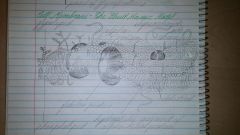
|
|
|
|
Name 2 components scattered in the cell membrane and their functions. |
1. Cholesterol allows animal cell membranes to function in a wide range of temperatures; maintains rigidity at high temperatures and fluid in low temperatures.
2. Proteins (integral and peripheral) function in the transport, recognition and binding sites (self), channels, pumps, and adhesion (gap and tight junctions) in the cell. |
Temperature for cholesterol, which is only found in animals. There are 6 for the proteins. Two Russian Boys Can Perform Acrobatics. |
|
|
Why is homoeostasis important for a cell? |
The conditions within a cell must remain relatively constant in order to function properly. |
|
|
|
What is water on both sides of the cell membrane? |
A solvent. |
|
|
|
What does the external environment of a protist contain? |
The external environment of a protist, such as amoeba contains other organisms, decaying organic matter, and dissolved gases. |
There are 3. |
|
|
In multicellular organisms every cell is bathed in a layer of... |
Extracellular fluid (ECF) also consisting of a variable mixture of water and dissolved materials. |
It's easier than you think. Mixture. |
|
|
What does semi-permeable mean in relation to the cell membrane? |
The membrane is semi-permeable controlling what can enter and exit; materials move through the cell membrane passively or actively. |
Control. Passive and Active. |
|
|
When do materials move through the cell membrane passively? |
Materials movie through the cell membrane passively through Brownian motion. No energy is expended by the cell. |
|
|
|
What is diffusion? |
Diffusion is the movement if molecules from a region where they are more concentrated to one where they are less concentrated (down a concentration gradient). |
Concentration. |
|
|
How is the diffusion rate increased? |
The diffusion rate increased when the surface area is large relative to the volume. |
|
|
|
What is osmosis? |
Osmosis is the diffusion of water across a semi-permeable membrane; α(alpha/is proportional to) [relative H2O] |
|
|
|
Describe osmosis in terms of hypersmotic and hypo-osmotic solutions? |
Hypersmotic solution has a higher concentration of solutes than a hypo-osmotic solution, therefore water move from hypo- to hypersmotic solutions. |
|
|
|
How does water move in isotonic solutions? |
Water moves in and out of the cell. |
|
|
|
When the hypotonic solution is outside of the cell, where does the water move? Explain why. |
Water moves into the cell; lysis. Water must move into the cell to lower the concentration of solutes which is higher on the inside than on the outside. |
|
|
|
When the hypertonic solution is outside of the cell, where does the water move? Explain why. |
Water moves out of the cell. Water must out of the cell to lower the concentration of solutes which is higher on the outside than on the inside. |
|
|
|
What is facilitated diffusion? |
Facilitated diffusion allows the diffusion of large molecules, such as glucose. |
|
|
|
How do carrier proteins and channel proteins aid in facilitated diffusion? |
Carrier proteins change shape allowing passage. Channel proteins provide H2O-filled passages for ions (aq). |
Passage. |
|
|
Why is active transportation necessary? |
To maintain homeostasis, some materials must be transported up a concentration gradient; to concentrate nutrients for growth, remove toxic wastes, etc. The intracellular environment must be kept different from the ECF. |
Intracellular environment. |
|
|
What percentage of energy from the body is used for active transport? |
40% |
|
|
|
Name at least 3 examples of active transport. |
3 of... 1. Kidney cells pump glucose out of urine into blood. 2. Intestinal cells pump nutrients from the gut. 3. Root cells pump nutrients from the soil or 4. Fish gill cells pump out sodium ions. |
|
|
|
Where does the Active Transport Pump get its energy from? |
Runs on energy from the cell metabolism. |
|
|
|
What does the "Growth Stage" incorporate and approximately how long is it? |
Interphase which lasts about 90% of the cell's lifetime. |
|
|
|
What happens during the Gap 1 (G1) phase of interphase? |
1. Pinocytosis - "drinking" dissolved substances. 2. Phagocytosis - "eating" particulate matter. 3. Receptor assisted molecules attach to special proteins. |
|
|
|
What happens during the synthesis (S) phase of interphase? |
DNA is replicated. |
Cell products. |
|
|
How does water move in isotonic solutions? |
Water moves in and out of the cell. |
|
|
|
When the hypotonic solution is outside of the cell, where does the water move? Explain why. |
Water moves into the cell; lysis. Water must move into the cell to lower the concentration of solutes which is higher on the inside than on the outside. |
|
|
|
When the hypertonic solution is outside of the cell, where does the water move? Explain why. |
Water moves out of the cell. Water must out of the cell to lower the concentration of solutes which is higher on the outside than on the inside. |
|
|
|
Name the three different types of endocytosis and how they work. |
1. Pinocytosis - "drinking" dissolved substances. 2. Phagocytosis - "eating" particulate matter. 3. Receptor assisted molecules attach to special proteins. |
|
|
|
What happens during the Gap 2 (G2) phase of interphase? |
The cell prepares to undergo division. |
|
|
|
What does the "Division Stage" incorporate? |
1. Mitosis - Division of nucleus 2. Cytokineses - Division of cytoplasm |
|
|
|
Why do cells have a "Division Stage"? |
Regeneration of damaged tissue; Growth; and Maintenance. |
E. g. Millions of red blood cells die each day and are replaced by new red blood cells formed through mitosis and cell division. |
|
|
How does the "Division Stage" occur in all somatic (body) cells? |
1. New cells are ______ of pre-existing cells. 2. Instructions to form each new cell are stored in the chromosomes within the nucleus. 3. Each chromosome is made up of 2 identical sister chromatids held together by a centromere. |
|
|
|
New cells produces are ______ of the pre-existing cell. |
Clones. |
|
|
|
What does mitosis function to ensure? |
Mitosis functions to ensure that the same number of chromosomes from cell to cell is maintained. |
|
|
|
What is the result of cell division? |
A parent cell becomes two daughter cells. |
|
|
|
All cells are female, therefore they are all...? (Excluding reproductive cells) |
Mother and daughter cells. |
|
|
|
When do sperm and egg cells becomes mother cells? |
Fertilization. |
|
|
|
What is the biological purpose of the cell? |
The entire biological purpose of the cell is to prolong the existence of its genetic code. |
|
|
|
How many chromosome do humans have? |
46 |
|
|
|
How is Down Syndrome caused? |
Down Syndrome is cause by an extra chromosome in the 21st spot. Trisomy 21. |
|
|
|
Cell division is... |
Mitosis + Cytokineses. |
|
|
|
The Cell Cycle is... |
Division + Interphase. |
|
|
|
What are the phases of mitosis? |
1. Prophase
2. Metaphase
3. Anaphase
4. Telophase |
I Prefer Mice And Talking Cats. P-MAT |
|
|
What is each single chromosome made up of? |
Each single chromosome is made up of identical chromatids. |
|
|
|
What happens during prophase? |
1. Chromatin condenses and thickens (supercoiling) to form duplicate chromosomes (X-shaped). 2. The nuclear membrane and nucleolus disappear. 3. Centrioles made up of microtubules migrate to opposite poles. 4. Spindle fibres made of microtubules form between two centrioles. |
There are 4 steps. |
|
|
What does prophase look like? |
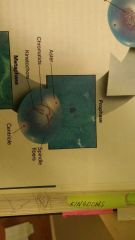
|
|
|
|
What does metaphase look like? |
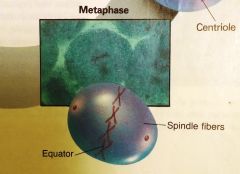
|
|
|
|
What happens during anaphase? |
Centromere splits and chromatids are pulled to opposite poles by the spindle fibres as the fibres shorten. |
This is where the action really happens! Remember "ana" means back. |
|
|
What does anaphase look like? |
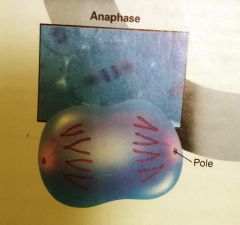
|
|
|
|
What happens during telophase? |
1. Chromatids reach opposite poles and each is now considered a single, non-replicated chromosome. 2. Chromosomes unwind and become less visible as chromatin. |
|
|
|
What does telophase look like? |
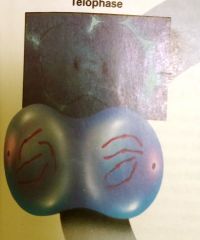
|
|
|
|
What happens during cytokinesis? |
1. Spindle fibres break down and disappear. 2. Nucleolus reappears. 3. Nuclear membrane forms around new set of chromosomes. 4. Cytoplasm divides between the two halves of the cell. |
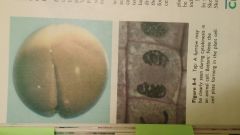
|
|
|
_________ can disrupt mitosis. |
Mutations. |
|
|
|
What are mutations caused by? |
Mutations are caused by mutagens (toxins, viruses, and radiation). |
|
|
|
What do mutations cause? |
Mutations cause a change in the DNA molecule and therefore are passed on to successive generations of cells via mitosis. |
|
|
|
Explain how smoking cigarettes can cause a mutation. |
Cigarettes contain a toxic compound which alters a gene called FHIT (Fragile Histidine Triad) on chromosome 3. In the lungs, cells containing the altered FHIT gene undergo uncontrolled mitosis, a tumour (cancer). |
|
|
|
What are genes activated by a mutation called? |
Oncogenes. |
|
|
|
Identify the two major chemical components of the cell membrane. |
Proteins and lipids. Proteins function as channels, pumps, transportation, recognition, binding sites, and adhesion. Lipids are found in phospholipids and cholesterol. |
|
|
|
Why is it that cells divide rather than increase in size? |
The surface area to volume ratio limits the size a cell can be... |
|
|
|
Describe the function of the course adjustment knob of a standard light microscope. |
Focuses an object. Moves tube or stage. Used with low-power lens only. |
|
|
|
Which of the following is not kingdom? a. eubacteria b. protista c. viruses d. plantae e. fungi |
c. viruses |
|
|
|
What is the cell membrane primarily composed of? |
Phospholipids and proteins |
|
|
|
If the nucleus is removed from one egg cell and replaced with the nucleus from an embryo, what is the offspring in relation to the cell that donates the nucleus? |
A clone |
|

